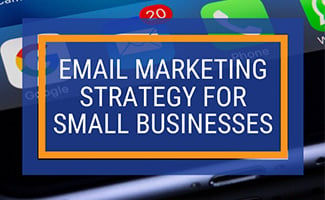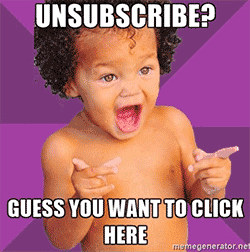When you purchase through links on our site, we may earn a commission. Here’s how it works.

Below we will take a look at the importance of including an email marketing plan into your small business model and touch on some of the best practices.
Article Overview
- What Is Email Marketing & What Is It Used For?
- Benefits For Small Businesses
- How To Get Started
- Why Email Marketing (Video)
- Tips From An Expert
- Is Email Marketing Worth It?
What Is Email Marketing?
Email marketing is a process of utilizing electronic mail to promote products and services to a target audience.
Top 8 Things Your Business Can Use Email Marketing For
- Discounts
- Promoting products
- Birthday, anniversary and special occasion wishes
- Special events
- Fundraising messages
- Soliciting sales
- Creating brand awareness
- Staying top of mind
While email communication between a small business and any potential or current customer could be considered to be email marketing (support, customer service and auto-responses), the primary purpose behind email marketing campaigns is to drive leads and increase conversions for your business.
4 Ways Email Marketing Is Beneficial For Small Businesses
There are a number of things that make email marketing a successful marketing tactic. Here are a few of the many benefits.
1) Cost-Effective: More Affordable Than Physical Mailings

These mailings, which generally take the form of flyers or postcards are relatively more expensive than their digital counterparts. The cost of a physical mailing encompasses not only design time, but printing, sending, and list acquisition costs. And of course, digital mailing are more eco-friendly.
Email marketing cuts out much of the added cost that comes with a physical mailing. That is not to say that email marketing is a replacement for physical mailing. However, it is a much more cost-effective method of marketing for small businesses working on a budget.
2) Timing: Real-Time Marketing
When it comes to physical mailings, there is also a time-lapse between when you create the campaign and when your customers receive it. In the case of email marketing campaigns, information can be sent to clients and potential clients as soon as it has been created. With the click of a button the message will arrive in a customer’s inbox.
3) Metrics: Knowing What Works And What Doesn’t

On the other hand, email marketing campaigns can be sent out to a test market of clients and potential clients for relatively little cost. Data can be automatically tracked by email marketing software and companies are able to determine which campaign receives a higher response.
This allows companies to improve their targeted marketing strategy for a low cost and time investment. This includes optimizing the day of the week and time of day an email is received.
4) Targeting: Making Marketing Personal
When clients and potential clients opt-in to an email newsletter, you have the ability to capture personal information including name, birthday and mailing preferences.
This information allows a business to create a more personalized and targeted email marketing campaign which helps to weed out potentially unsuccessful mailings that take additional time and effort. It also gives you the ability to address your subscriber by name, send them birthday discounts and send them what they want when they need it.
How To Get Started With Email Marketing
Getting started with small business email marketing is actually a relatively easy and painless process.
First, identify an employee with enough technical knowledge to run email marketing software (if you’re not sure what this entails, anyone with basic computing, website, and spreadsheet experience should be able to learn relatively quickly). There are also third-party marketing agencies that can help with design and execution. Some email marketing companies also offer full service for an additional fee, so consider this before ditching a potential provider due to lack of technical expertise.
Next, determine your potential email list size and the best way to collect email addresses. Do you have a website that allows for a signup box, or perhaps a POS (point of sale) system that can collect email addresses upon checkout? Maybe you have an existing database you have been sitting on and not using. Figure out about how many people you plan to market to and how frequently. Most email marketing services charge by the number of emails you plan to send, so you’ll need to know this figure when shopping around for price.
What features will you need or use is another factor to consider when getting started. We compare the top email marketing providers with pros, cons, features, pricing, and user feedback.
Does Email Marketing Have The Highest Conversion Rate Of Any Marketing Channel? (Video)
We created this video to show you some of the many reasons your business should be using email as part of your marketing efforts. Not the least of which – did you know that email marketing has the highest conversion rate (66%) of any marketing channel?
Email Marketing Tips From An Expert

3 Primary Goals Of Email Marketing
You do have goals, right? Possible email marketing goals could include:
- Brand Awareness (aka, “read my emails!”) – you are sending out emails with the hope that people read them. More people reading = more consumer education about your product and/or service.
- Website Pageviews (aka, “click through, please!”) – you are sending out emails with the hope that people will to open them, then click on one or more links which point back to your website and/or blog. More click-throughs = more pageviews.
- Conversion (aka, “buy stuff!”) – you are sending out emails with the hope that people will open, click, and ultimately buy something. This “conversion” does not have to be a product or service, but could be a whitepaper (or eBook), a PDF, audio or other download, or a webinar registration.
4 Components Of A Killer Email
Okay. Have you picked your email marketing goal? Good. Now, let’s move on to the four primary components of a killer email.
1. Recognizable And Trusted “From:” Name
If you want someone to open your email (vs. delete it or mark it as spam), it’s important that you are a recognizable and trusted sender. Many people don’t take the time to read every single email in their inbox before making the “send to trash” decision.
We skim. Think about the emails you open vs. the ones you delete. If you don’t recognize who it’s from, you are less likely to open it. If you do know the sender, yet the emails they typically send are not all that valuable, you’re also less likely to open it.
2. Subject Line That Stands Out

Sure, there may be some instances when a boring subject line can work (most often when the sender is recognizable and trusted – see tip 1), but for the most part a compelling email subject line is going to stand out in the inbox.
This is one of the reasons we are seeing an uptick in marketers using emojis in their subject lines. They are unique. They cause you to pause for just a split second. That split second is often all it takes for your email to stand out … and get opened.
Will this strategy last? Maybe not, but there’s always new ones around the corner. So it helps to stay on top of the trends – just scroll down and subscribe to our newsletter to do so.
3. Call To Action That’s Clear And Compelling
If you have to make me guess what action you want me to take in your email, you’ve already lost me. Don’t make your subscribers work for it. Make your call to action clear, obvious and so in your face that it’s impossible to miss.
I can’t tell you the number of emails I get where I scratch my head after 7 or 8 seconds … pondering what I’m supposed to do next. Having your subscribers ponder the next action in your email is not going to help your conversions – make your links and other actions simple, straightforward, and easy to access.
4. Unsubscribe That’s Easy And Obvious

If someone no longer finds your emails valuable, make it easy for them to opt-out. You don’t need to create a new unsubscribe image for each email you send (like Chris Penn does – though his are pretty awesome).
However whatever you do, don’t make your subscribers work to opt-out. If they have to search for the opt-out and/or you make them jump through hoops to get off your list, they are more likely to hit the “mark this as spam” button. That action can add up to negatively impacting your overall email deliverability. You do not want this.
All of that being said, you still have to test what works best for your specific audience. Remember: Email marketing best practices only apply if they work for your audience.
Is Email Marketing Worth The Expense?
One of the biggest predicaments for small business owners when it comes to most decisions is whether or not the initial cost is going to be worth it?
When it comes to email marketing, assuming that a company a) has the knowledge to properly utilize an email marketing solution or b) utilizes a full-service email marketing solution, the return on your investment is almost always worth the expense. Monthly costs for these services are minimal and are scaled to fit the number of subscribers that a business has at the beginning of the billing period.
This means that the larger the viewing audience for marketing materials is, the higher the monthly cost and yet in the vast majority of cases even large audience accounts pay less per month of mailing than they would for a single physical mailing campaign.
Learn more about email marketing with our B2B guide and check out the providers we recommend.
Have you used email marketing for your small business? Let us know your success (or frustration) in the comments!
Tagged With: Email Marketing


